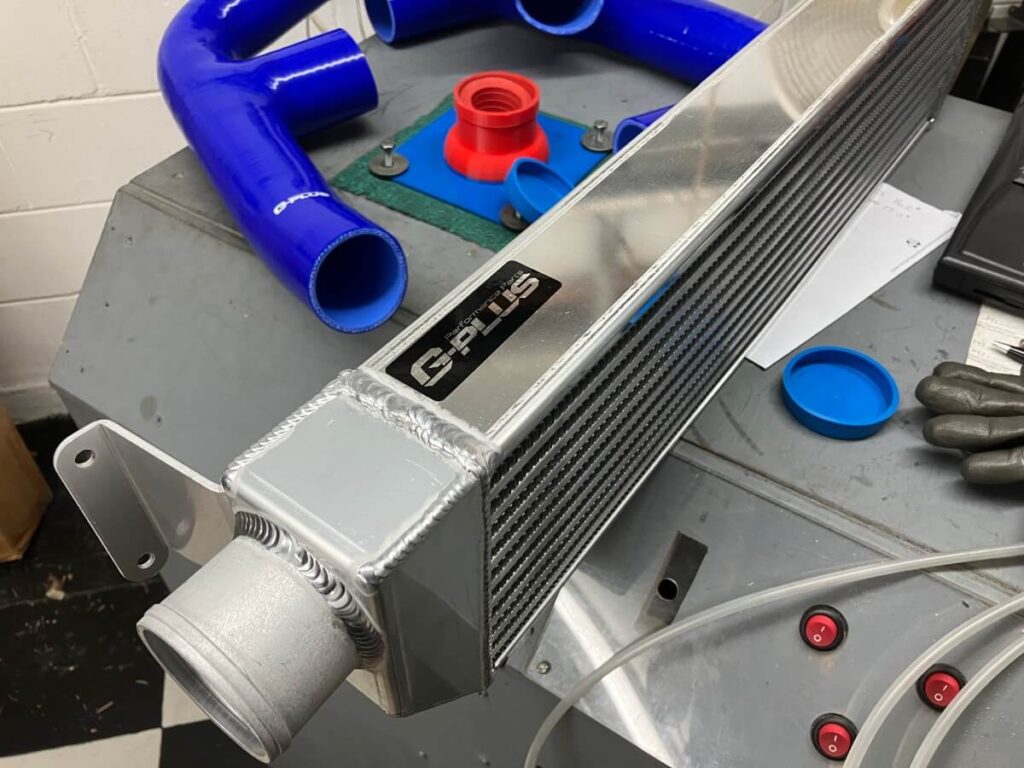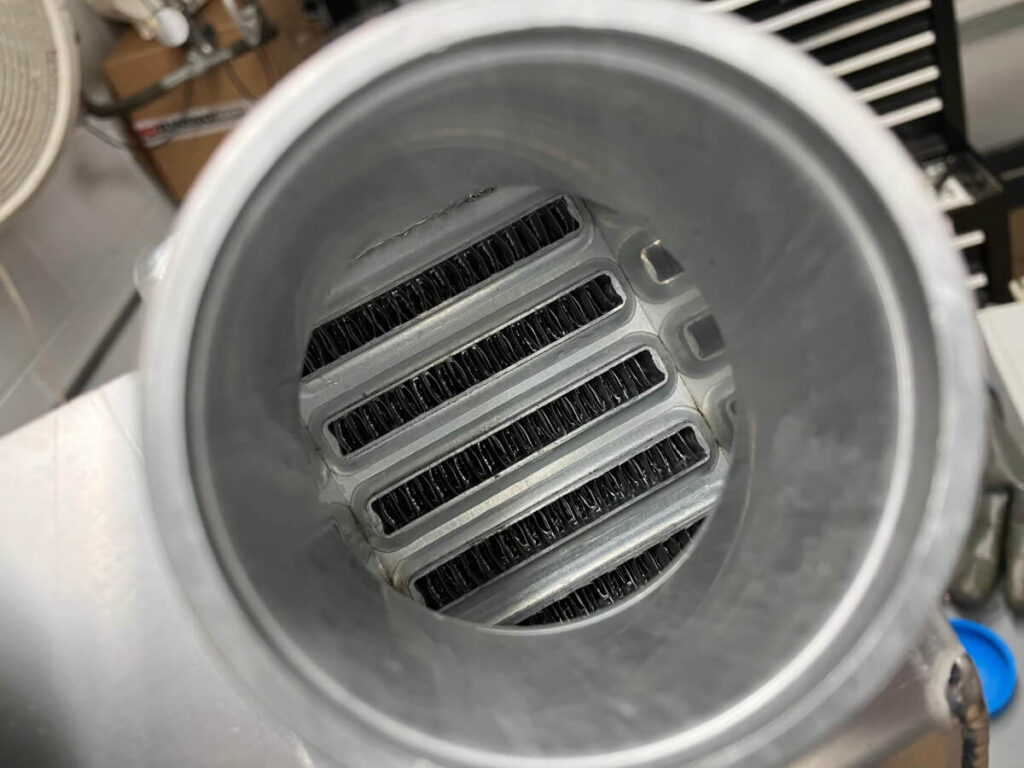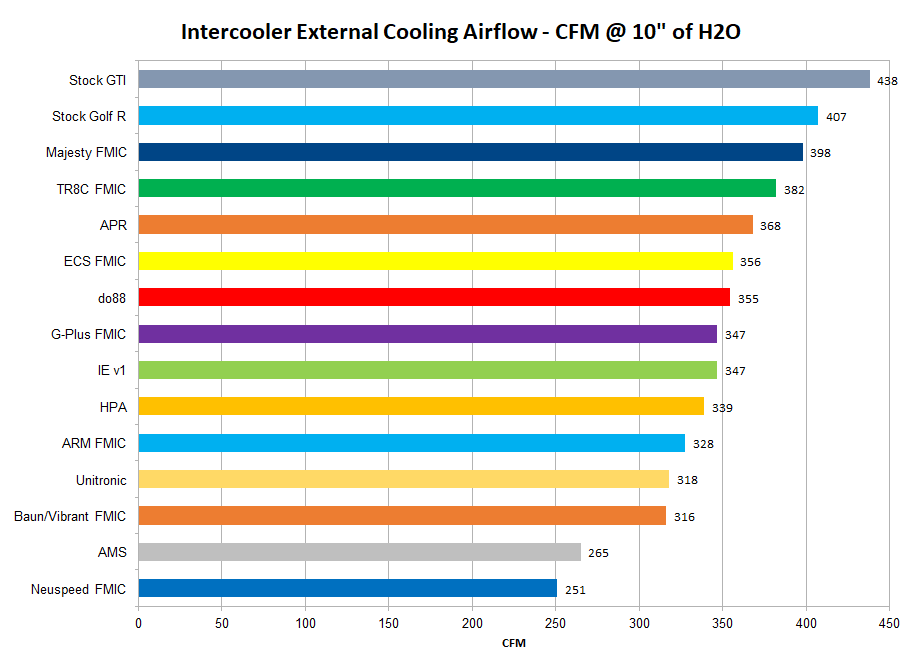Background:
The G-Plus bicooler for the Mk7 GTI is the subject of a flow test.

An interesting observation about my sample is that it is a Tube and Fin design. This is the only Tube and Fin FMIC for the Mk7 that I am aware of.

Test Procedure:
After completing a calibration check of the flow bench the G-Plus intercooler is first tested for airflow rate through the external cooling fins.
This measurement is made by setting the intercooler on top of an adapter that is fixed to the flow bench. Air is then drawn through the G-Plus at a depression of 10″ of H2O. The intercooler is rotated twice noting the airflow value at each position. The three values are used to calculate an average airflow through the external fins.
Next, the G-Plus is attached to the flow bench using a short length of straight silicone coupler hose. At the inlet side, another piece of silicone hose is attached and a bellmouth is inserted into the hose to help air smoothly enter the intercooler.
Airflow through the intercooler is measured at 28″ of H2O.

The G-Plus is next connected to a GTI stock intercooler using the supplied silicone hoses. This allows for measuring airflow through the system in the intended “bicooler” configuration.
Due to the difficulty of trying to attach the entire bicooler setup to the flow bench directly, the throttle body side charge pipe is attached to the outlet silicone hose of the bicooler and the charge pipe is attached to the flow bench. This likely results in a small decrease in the system airflow. I estimate the difference is no greater than 5 CFM based on results that have been measured during charge pipe testing.
Airflow through the bicooler is measured at 28″ of H2O.

Test Results:
The G-Plus intercooler flows 347 CFM @ 10″ of H2O through the external fins. This is shown on the chart with all other intercoolers that have been tested:

Flow testing of the intercooler interior measured 143 CFM @ 28″ of H2O when the G-Plus was attached directly to the flow bench.
When configured as a bicooler with the stock GTI intercooler the system flowed 260 CFM @ 28″ of H2O.

Conclusions:
The G-Plus bicooler is flow tested for external and interior flow rates.
The exterior airflow through the G-Plus is 347 CFM @ 10″ of H2O. This ranks right around the average for all of the intercoolers that have been tested thus far.
The airflow through the G-Plus when tested alone is 143 CFM @ 28″ of H2O which is second to last of the products that have been tested.
Note: The G-Plus is intended to be used as a bicooler, it’s under-sized relative to the dedicated FMICs, and the lower airflow through the IC reflects the size difference.
As a bicooloer paired with the stock GTI IC the G-Plus flows 260 CFM @ 28″ of H2O. This is the third-highest airflow of all FMIC and bicooler setups that have been tested.
Note: This is also greater than all stock location aftermarket ICs that have been tested other than the do88 IC which flows slightly more at 267 CFM @ 28″ of H2O.
The G-Plus is a good example of how a bicooler can significantly increase airflow compared to a FMIC.

Articles like this give me that little nudge to get the bi-cooler setup going. I have the ARM FMIC and was contemplating just ordering the G-Plus for the hoses so I could utilize the stock IC.
Although lowering pressure drop is “beneficial”, I don’t have an idea of the extent of the effect on power output.
Fair enough. I wanted to put the stock IC to work, but I also rather save myself a few hundred dollars if there is nothing gained on a dd that never sees the track.
I doubt there is any gain worth the cost for the use you’re describing. The ARM IC works pretty well. Eventually, I’ll try and figure out at what point lower airflow starts to make a difference.
I assume your implication here is that for a budget / DD build this should be more then sufficient? Planning on going this route with my IS38 1.8T
The pressure drop produced by the G-Plus configured as a bicooler is less than most options, I don’t think there will be any issues caused by the pressure drop.
Thanks Jeff! I picked one up for my IS38 Wagon
You’re welcome!
I’ve got this intercooler on my gti now! Seeing temperature deltas of 20°F-25°F above ambient at 3rd gear wot on a 85°F day. Obviously anecdotal but by golly I think this thing works